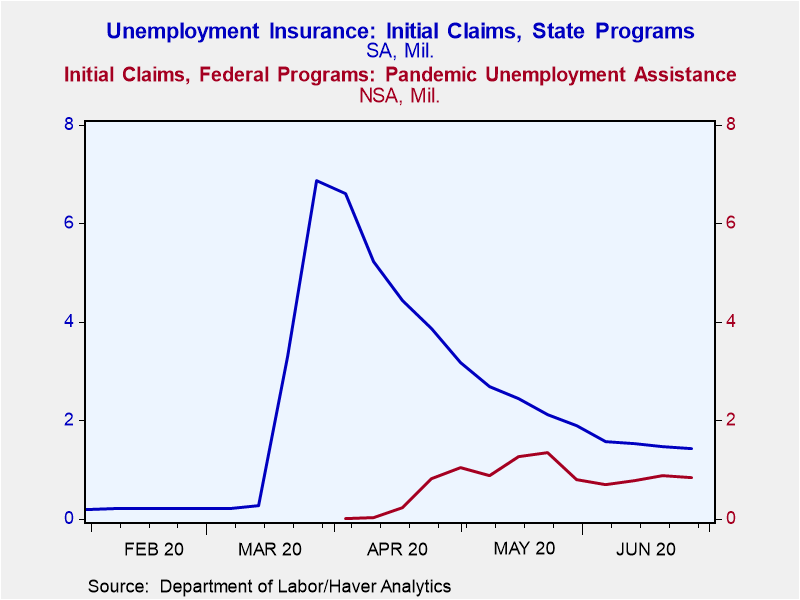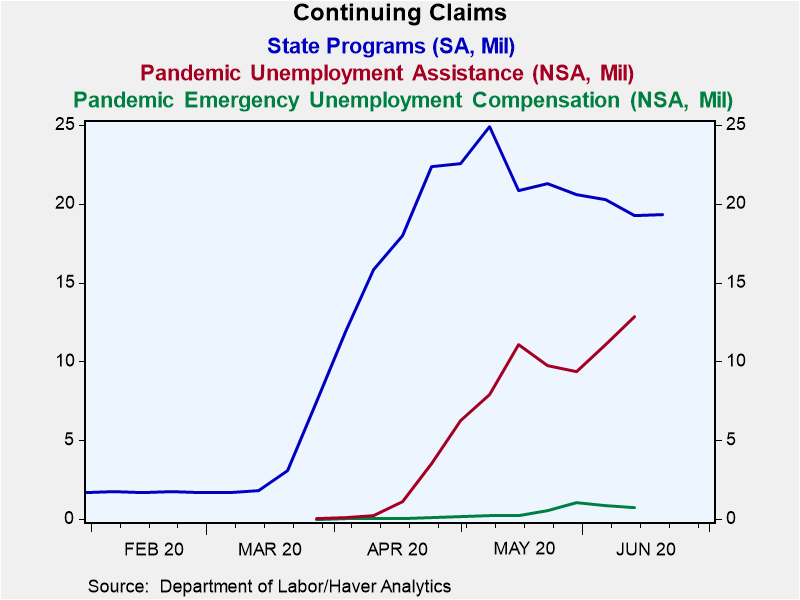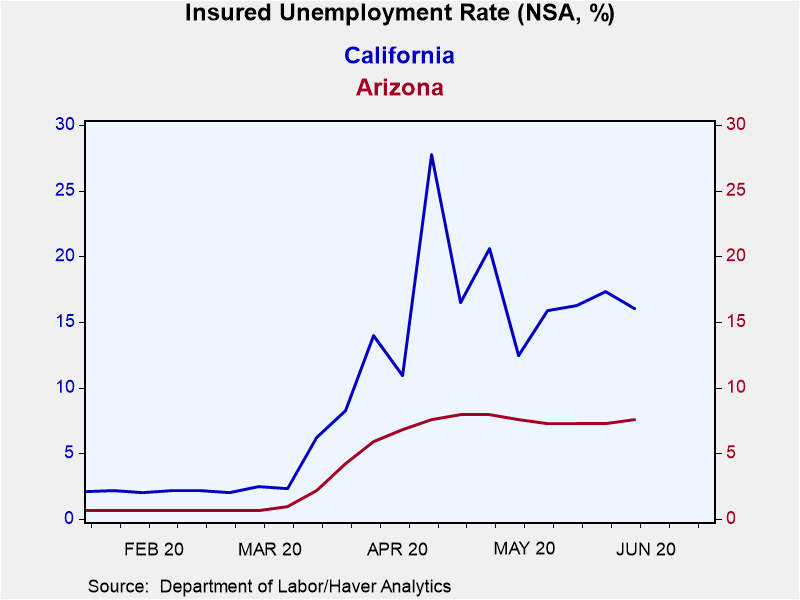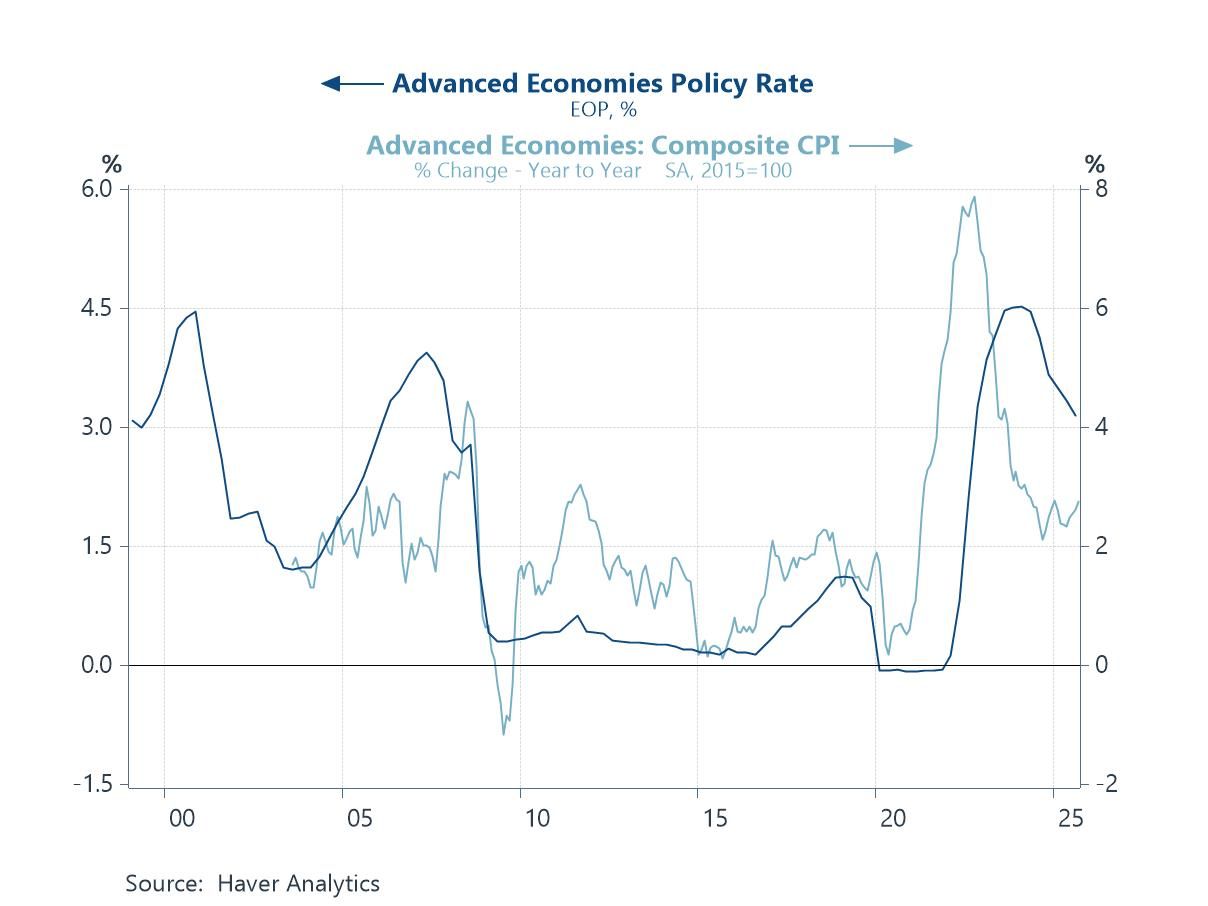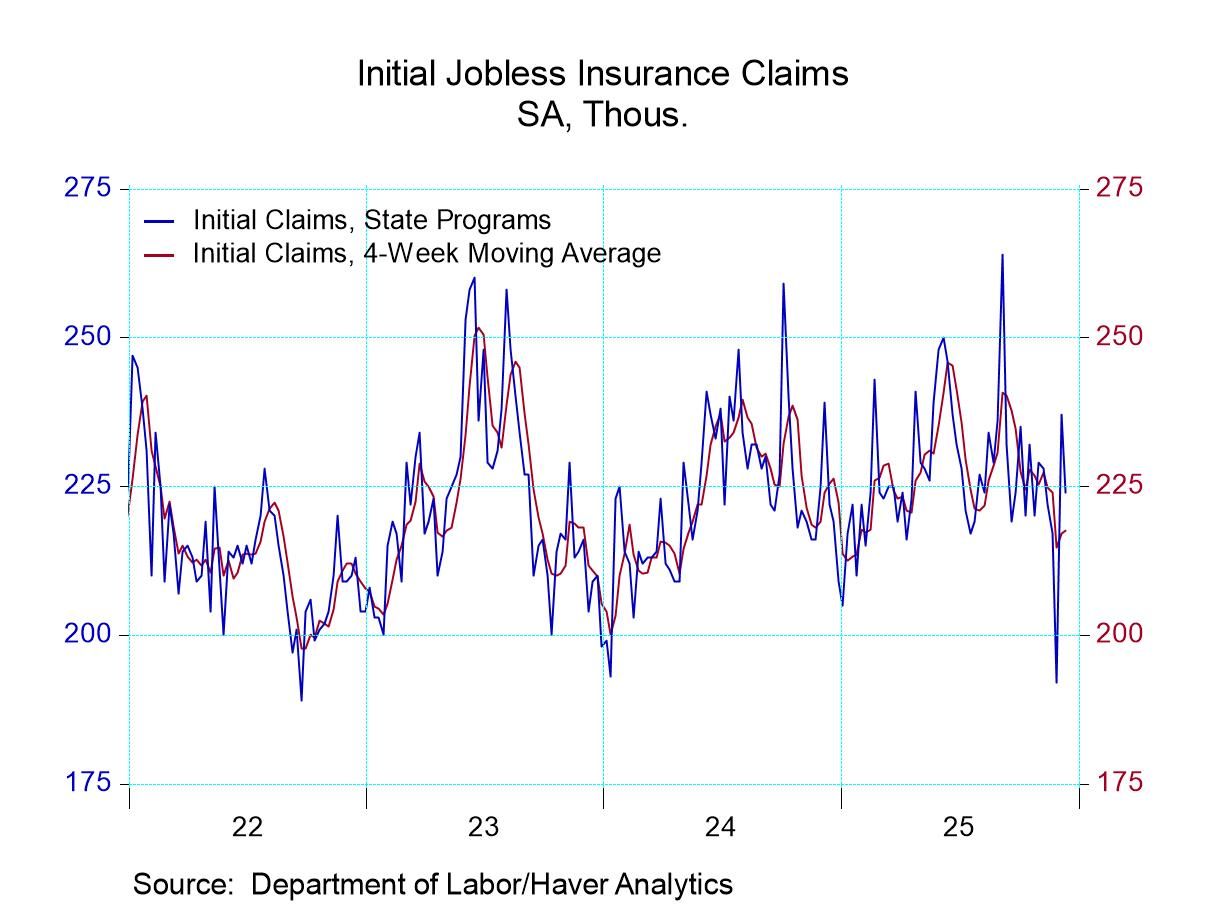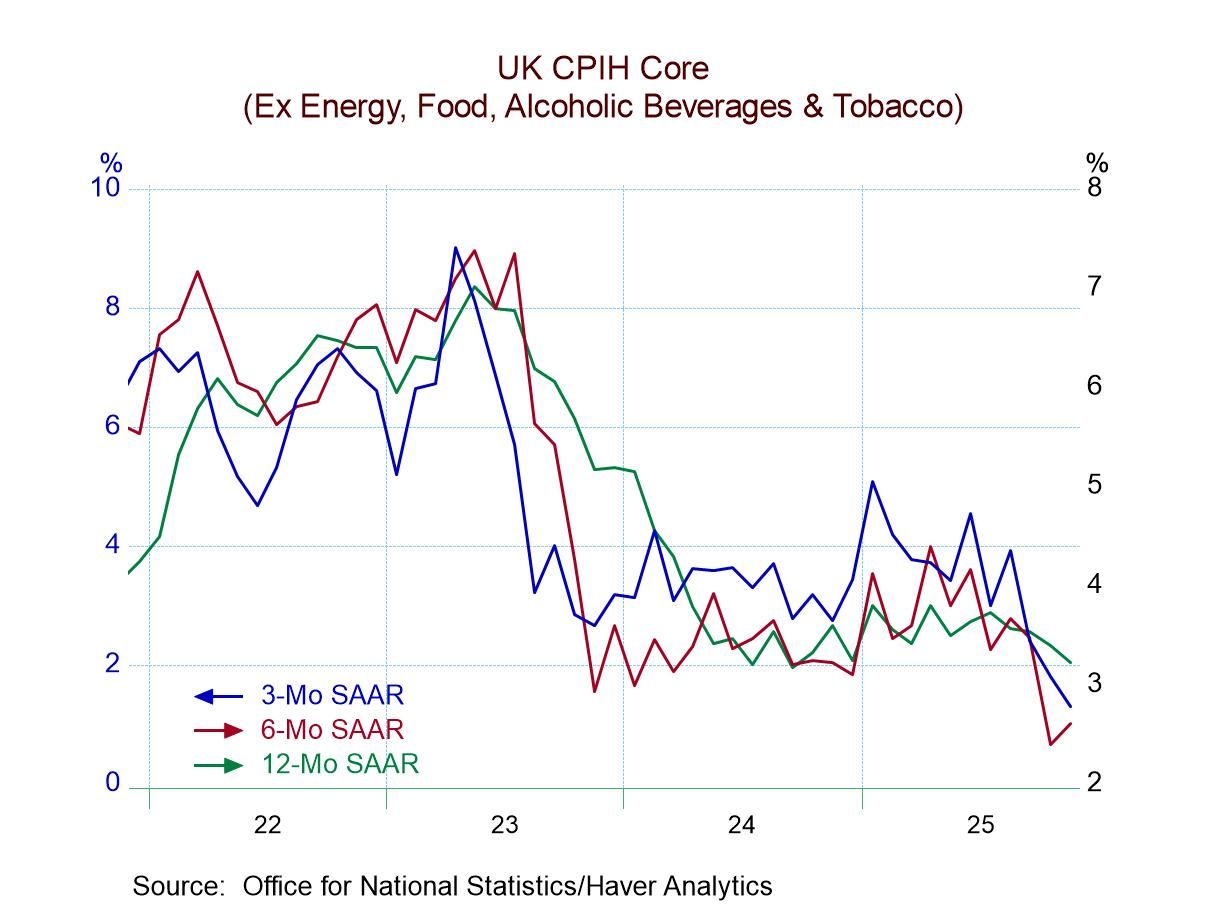 Global| Jul 02 2020
Global| Jul 02 2020State & Pandemic Assistance Initial Claims at 2.3 Million; Continuing New High of 32.9 Million
Summary
• State initial jobless claims decreased to a still extremely-elevated 1.427 million in the week ending June 27. • Federal Pandemic Unemployment Assistance new filers at 839,563. • Continuing claims for state programs rise to 19.3 [...]
• State initial jobless claims decreased to a still extremely-elevated 1.427 million in the week ending June 27.
• Federal Pandemic Unemployment Assistance new filers at 839,563.
• Continuing claims for state programs rise to 19.3 million; PUA increases to 12.9 million.
• Twenty-seven states had insured unemployment rates above 10%, two over 20%.
State initial jobless claims for unemployment insurance decreased to 1.427 million during the week ending June 27 from a slightly upwardly-revised 1.482 million (was 1.480 million). The Action Economics Forecast Survey anticipated 1.225 million claims. While substantially lower than the weekly peak of 6.9 million new filers in late March, the current level of initial claims remains well above the previous record of 695,000 set in 1982. The four-week moving average of initial claims, which smooths out week-to-week volatility, but is less important at the moment because of the rapidity of changing conditions, decreased to 1.504 million from 1.621 million.
Claims for the federal Pandemic Unemployment Assistance (PUA) program, which covers individuals such as the self-employed who are not qualified for regular/state unemployment insurance, decreased to 839.563 in the week ending June 27 from an upwardly-revised 881,242 (was 728.120). In this week's report, the history of PUA claims was revised and now includes data for the first half of April. The total for this series is now 394,400 higher. PUA claims now peaked at 1.348 million in the week ending May 23. Numbers for this and other federal programs are not seasonally adjusted.
Continuing claims for unemployment insurance declined to 19.290 million in the week ending June 20, from a downwardly-revised 19.231 million (was 19.522 million). Continuing PUA claims, which are lagged an additional week, jumped to 12.853 million from 11.067 million (was 11.046 million). Continuing PUA claims were also revised with added history. The total for this series is now 758,793 higher. Pandemic Emergency Unemployment Compensation claims decreased to 749,703 in the week ending June 13. This program covers people who were unemployed before COVID but exhausted their state benefits and are now eligible to receive an additional 13 weeks of unemployment insurance, up to a total of 39 weeks.
The insured rate of unemployment was unchanged at 13.2% in the week ending June 20; the previous week was revised down to 13.2% from 13.4%. This data does not include the federal pandemic assistance programs. If you include the latest data available, which is lagged one additional week, the number of continuing claims increased to a new high of 32.9 million or 20.6% of the labor force. This is up from downwardly revised 31.2 million in the previous week (was 31.4 million) and the previous peak of 32.6 million in late May (was 32.4 million prior the revisions discussed above).
The state insured rates of unemployment -- which do not include federal programs -- continued to show wide variation with South Dakota at just 4.1% and Nevada at 21.4%; the other state above 20% was Hawaii at 21.3%. Twenty-seven states had rates over 10%. The largest states ranged between 9.9% for Texas and 17.5% for New York. The state rates are not seasonally adjusted.
Data on weekly unemployment claims going back to 1967 are contained in Haver's WEEKLY database, and they are summarized monthly in USECON. Data for individual states are in REGIONW. The expectations figure is from the Action Economics Forecast Survey, carried in the AS1REPNA database.
| Unemployment Insurance (SA, 000s) | 06/27/20 | 06/20/20 | 06/13/20 | Y/Y % | 2019 | 2018 | 2017 |
|---|---|---|---|---|---|---|---|
| Initial Claims | 1,427 | 1,482 | 1,540 | 543 | 218 | 221 | 244 |
| 4-wk Average | 1,504 | 1,621 | 1,782 | -- | -- | -- | -- |
| Initial Claims Pandemic Unemployment Assistance (NSA) | 840 | 881 | 774 | -- | -- | -- | -- |
| Continuing Claims | -- | 19,290 | 19,231 | 1,035 | 1,701 | 1,756 | 1,961 |
| 4-week Average | -- | 19,854 | 20,349 | -- | -- | -- | -- |
| Continuing Claims Pandemic Unemployment Assistance (NSA) | -- | -- | 12,853 | -- | -- | -- | -- |
| Insured Unemployment Rate (%) | -- | 13.2 | 13.2 |
1.2 |
1.2 | 1.2 | 1.4 |
Gerald D. Cohen
AuthorMore in Author Profile »Gerald Cohen provides strategic vision and leadership of the translational economic research and policy initiatives at the Kenan Institute of Private Enterprise.
He has worked in both the public and private sectors focusing on the intersection between financial markets and economic fundamentals. He was a Senior Economist at Haver Analytics from January 2019 to February 2021. During the Obama Administration Gerald was Deputy Assistant Secretary for Macroeconomic Analysis at the U.S. Department of Treasury where he helped formulate and evaluate the impact of policy proposals on the U.S. economy. Prior to Treasury, he co-managed a global macro fund at Ziff Brothers Investments.
Gerald holds a bachelor’s of science from the Massachusetts Institute of Technology and a Ph.D. in Economics from Harvard University and is a contributing author to 30-Second Money as well as a co-author of Political Cycles and the Macroeconomy.


